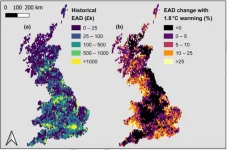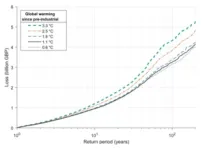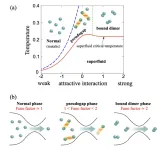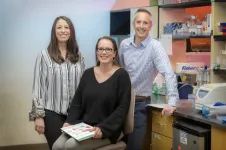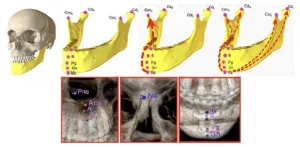(Press-News.org) Annual damage caused by flooding in the UK could increase by more than a fifth over the next century due to climate change unless all international pledges to reduce carbon emissions are met, according to new research.
The study, led by the University of Bristol and global water risk modelling leader Fathom, reveals the first-ever dataset to assess flood hazard using the most recent Met Office climate projections which factor in the likely impact of climate change.
Its findings show the forecasted annual increase in national direct flood losses, defined as physical damage to property and businesses, due to climate change in the UK can be kept below 5% above recent historical levels. But this is only on the proviso that all countries fulfil the ambitious pledges they signed up to at COP26 and also that countries, including the UK, which made further Net Zero commitments, actually achieve these on time and in full.
If the COP26 and Net Zero promises are not collectively met, the study shows the annual cost of flooding in the UK over the next century could grow by between 13% and 23%, depending on different levels of climate extreme projections.
Lead author Paul Bates, Professor of Hydrology and Chairman of Fathom, said: “For the first time this flood model gives us a more accurate and detailed picture of the impact of climate change on the risk of flooding in the future across the UK. The results are a timely warning to the country’s political leaders and business sector that global commitments to significantly reduce carbon emissions must be taken very seriously, and ultimately take effect, in order to mitigate increased losses due to flooding.”
The sophisticated data has also highlighted the places in the UK where risks will increase most rapidly, even under the best-case scenario where global warming is limited to 1.8 degrees C. These include South East England, South Wales, North West England and Central Scotland, especially densely populated cities such as London, Cardiff, Manchester, Glasgow, and Edinburgh, where damage increases of more than 25% are possible.
Conversely, the new model indicated flood hazards in North-East and Central England as well as Eastern and Northern Scotland change very little from the present day.
“Although the most optimistic climate scenarios see only modest increases in flood losses at a national level, these new data demonstrate how this conceals dramatic variations across the country, with some places seeing large changes and others very little. This is a result of changing patterns of future rainfall, river flow and sea level rise, and this leads to the regional differences we predict,” said Professor Bates.
“We found that flooding increases most in places where risk is already high now, so the best thing we can do to prepare for the impact of climate change is to strengthen flood management in currently at-risk areas, and this will bring immediate economic and social benefits as well."
The modelled estimates of historical flood risk, which are based on actual river flow, rainfall, and tide-surge observations as well as climate model projections, match well with data on flood losses from the Association of British Insurers, and shed new light on the financial toll of flooding. Previous studies by other research groups have already shown that historical UK economic losses due to flooding were three times less than the Government’s estimates, but this is the first time the observed losses have been replicated and corroborated by a computer model.
The team of researchers plan to produce analysis for other countries across the world, furthering our understanding of how climate change is likely to affect flood risk globally.
Co-author Dr Oliver Wing, Chief Research Officer at Fathom and Honorary Research Fellow at the University of Bristol, said: “This study, which harnesses new data and the very latest modelling techniques, validates Fathom’s UK Flood Map and has given a new level of insight into the impact of climate change on flooding in future.
“The modelling provides clear evidence that flood risk needs to be a bigger international priority and that current governance doesn’t go far enough. While the majority of the nation’s future flood risk already exists today, it is strongly in the UK’s interest to exercise leadership in global carbon emission reduction efforts, both by example and as part of global diplomatic initiatives.”
END
Pioneering study shows flood risks can still be considerably reduced if all global promises to cut carbon emissions are kept
2023-03-07
ELSE PRESS RELEASES FROM THIS DATE:
Tracing 13 billion years of history by the light of ancient quasars
2023-03-07
Astrophysicists in Australia have shed new light on the state of the universe 13 billion years ago by measuring the density of carbon in the gases surrounding ancient galaxies.
The study adds another piece to the puzzle of the history of the universe.
“We found that the fraction of carbon in warm gas increased rapidly about 13 billion years ago, which may be linked to large-scale heating of gas associated with the phenomenon known as the ‘Epoch of Reionisation’,” says Dr Rebecca Davies, ASTRO 3D Postdoctoral ...
Wings, not webs: Certain bugs are the winners of urbanization, impacting cities’ insect diversity
2023-03-07
Cities are bursting with life, both human and animal. The smallest of them, insects, spiders, and ants are easily overseen, but their presence – or absence – in cities has wide-reaching effects. Scientists in Austria have published a study in Frontiers in Ecology and Evolution, which found a correlation between the presence of arthropods – invertebrate animals with an exoskeleton; among them are bees, insects, and spiders – and level of urbanization.
“We show that richness and diversity of arthropods on trees and bushes decreases along the rural-urban gradient,” said first author Dr Marion Chatelain, a postdoctoral ...
Quantum crossover: How to distinguish single-particle and pair currents
2023-03-07
If you cool down low-density atomic gas to ultralow temperatures (−273°C), you get a new state of matter called the Bose-Einstein Condensate (BEC). A BEC has strongly coupled two-atom molecules behaving like a collective wave following quantum mechanics. Now if you reduce the pairing strength between them—for example, by increasing the magnetic field—the atoms form “Cooper-pairs” according to Bardeen-Cooper-Schrieffer (BCS) theory—a Nobel Prize winner. The process is called BCS-BEC crossover. And the theory forms the basis ...
Females of all ages, sexes have more salt- sensitive hypertension than males
2023-03-07
There is increasing evidence that females of all ethnicities and ages are more salt sensitive than males, and that this propensity to hold onto more salt, which drives blood pressure up, increases after menopause.
Another important emerging bottom line is that healthy blood pressures might differ between the sexes, which means females might benefit from earlier and different intervention to avoid damage to their heart and vasculature.
“The realities are that women and men regulate our blood pressure differently and our blood pressures are different at baseline,” says Dr. Eric Belin de Chantemele, physiologist in the Vascular Biology Center at the Medical College of Georgia at ...
Mass General Brigham study finds virtual care team strategy improved treatment for heart failure patients
2023-03-06
Recent studies have provided strong evidence that patients with heart failure can benefit from medical therapies that can reduce risk of worsening symptoms and extend patients’ lives. But, despite new guidelines, adoption of these therapies has been slow, incomplete and inequitable. A prospective clinical study by investigators from Mass General Brigham evaluated a new approach to improve use of these therapies by putting in place a virtual care team, consisting of physicians and pharmacists, to help guide treatment strategies for patients seeking care at three Mass General Brigham hospitals: Brigham and Women’s Hospital (BWH), Brigham and Women’s Faulkner Hospital ...
Deep-learning-based anatomical landmark identification in CT scans
2023-03-06
Millions of people around the world undergo some type of orthodontic treatment each year due largely to developmental deformities in the jaw, skull, or face. Computed tomography (CT) imaging is the go-to technique for surgeons when planning such treatments, especially surgeries. This is because CT provides 3D images of the bones and teeth, which helps the surgeon analyze complex cases in detail and determine the best treatment procedure based on that.
During the CT scan, surgeons typically try to pinpoint specific anatomical landmarks in the images. These are distinct points in the human body that can be used as a reference to make measurements and assess a condition ...
The challenges of mining for electric-vehicle batteries
2023-03-06
In August 2022, Congress passed the Inflation Reduction Act (IRA). Signed by President Joe Biden, the legislation attempted to curb inflation, lower the deficit, and invest heavily into domestic clean energy.
One aspect of the bill was setting a market value-based target for battery-critical mineral content in electric vehicles (EVs). By 2027, for an EV to be tax-credit eligible, 80 percent of the market value of critical minerals in its battery must be extracted or processed domestically or by US free-trade partners (FTPs).
While this goal is well-intended, there are reasons to believe the mandate is unreachable and could create new problems.
In a commentary published ...
AI chatbot ChatGPT mirrors its users to appear intelligent
2023-03-06
LA JOLLA (March 6, 2023)—The artificial intelligence (AI) language model ChatGPT has captured the world’s attention in recent months. This trained computer chatbot can generate text, answer questions, provide translations, and learn based on the user’s feedback. Large language models like ChatGPT may have many applications in science and business, but how much do these tools understand what we say to them and how do they decide what to say back?
In new paper published in Neural Computation on February 17, 2023, Salk Professor Terrence Sejnowski, ...
Advancing engineering
2023-03-06
(Santa Barbara, Calif.) — UC Santa Barbara professors Thuc-Quyen Nguyen and Carlos G. Levi are among 106 new members of the National Academy of Engineering. Academy membership honors those who have made outstanding contributions to “engineering research, practice or education, including, where appropriate, significant contributions to the engineering literature” and to “the pioneering of new and developing fields of technology, making major advancements in traditional fields of engineering, or developing/implementing innovative approaches to engineering education.”
“Our campus ...
Microscopic chalk discs in oceans play a key role in earth’s carbon cycle by propagating viruses
2023-03-06
A Rutgers-led team of scientists studying virus-host interactions of a globally abundant, armor-plated marine algae, Emiliania huxleyi, has found that the circular, chalk plates the algae produce can act as catalysts for viral infection, which has vast consequences for trillions of microscopic oceanic creatures and the global carbon cycle.
“In a drop of seawater, there will be about 1,000 to 10,000 E. huxleyi cells, and about 10 million viruses,” said Kay Bidle, a professor in the Department of ...
